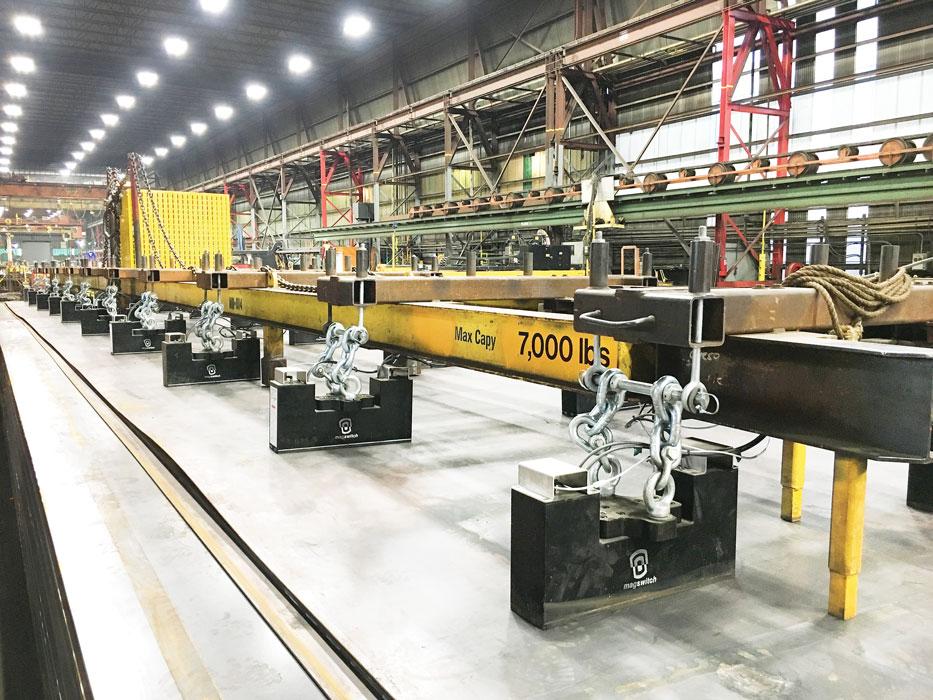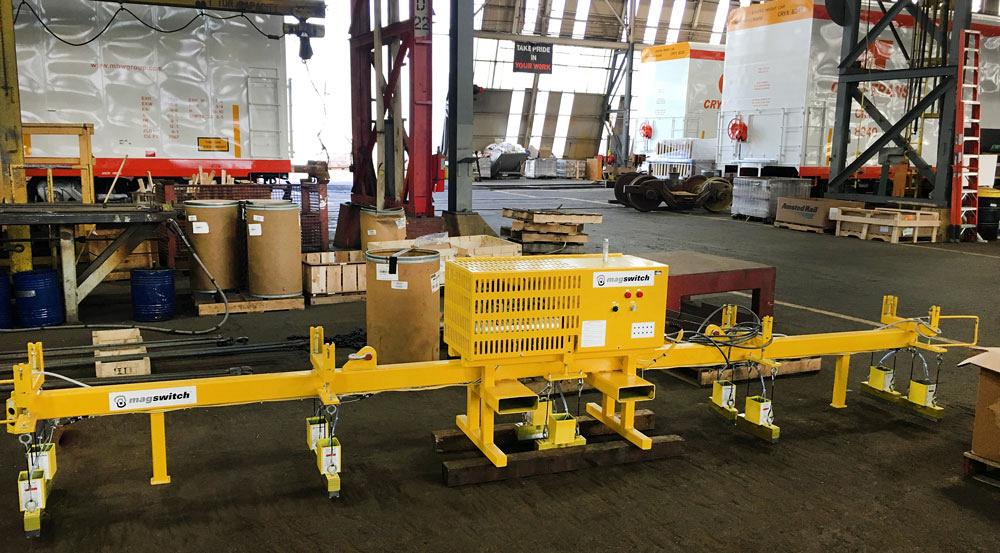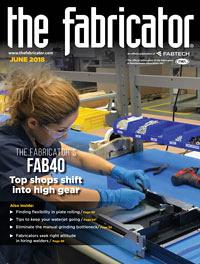- FMA
- The Fabricator
- FABTECH
- Canadian Metalworking
Categories
- Additive Manufacturing
- Aluminum Welding
- Arc Welding
- Assembly and Joining
- Automation and Robotics
- Bending and Forming
- Consumables
- Cutting and Weld Prep
- Electric Vehicles
- En Español
- Finishing
- Hydroforming
- Laser Cutting
- Laser Welding
- Machining
- Manufacturing Software
- Materials Handling
- Metals/Materials
- Oxyfuel Cutting
- Plasma Cutting
- Power Tools
- Punching and Other Holemaking
- Roll Forming
- Safety
- Sawing
- Shearing
- Shop Management
- Testing and Measuring
- Tube and Pipe Fabrication
- Tube and Pipe Production
- Waterjet Cutting
Industry Directory
Webcasts
Podcasts
FAB 40
Advertise
Subscribe
Account Login
Search
Gunderson Marine finds a way to keep sheets from falling from cranes
Gunderson Marine finds a way to keep sheets from falling from cranes
- June 5, 2018
- Article
- Materials Handling

Figure 1
Magswitch retrofitted this large spreader bar with new magnets, controls, and wiring system.
Gunderson Marine, Portland, Ore., and Magswitch Technology, Lafayette, Colo., have collaborated on a new custom lifter system that keeps steel sheets from falling from cranes.
Gunderson Marine has worked to maintain a safe working culture over almost 100 years of manufacturing. It has built more than 2,000 marine vessels over the years and currently has about 800 employees. It also has branched out to railcar manufacturing over the years.
“I don’t think anybody is ever really satisfied with its safety record. It can always be improved,” said Marvin Walz, a superintendent for material handling and a 42-year veteran of Gunderson Marine. “We have been on a downward trend [with incident rates] in the last few years, and we have been able to cut our incident rates down by, I believe, more than three-quarters.”
As part of the company’s continuous improvement efforts, management is always looking to limit employees’ exposure to risk. That’s why Walz wanted to take a closer look at an old lifting frame device that was used to handle 65- by 8-foot steel sheets. The aging electromagnetic lift system had done the job over the years, but it was struggling with destacking 3/16-inch sheet. The system would either grab multiple sheets, or when it was able to pick up just one, the sheet might drop or peel off while being transported.
This was of particular concern as the old lift frame was used frequently in the plant. The frame, which was about 60 by 8 ft. with 20 magnets, was attached to a 20-ton overhead crane and used to move steel sheets to one of two 60- by 20-in. plasma cutting tables. Each sheet is cut into two pieces and fabricated into railcar walls.
Gunderson found a resolution in new magnets from Magswitch Technology. By using the same technology that it uses in its robotic business, Magswitch was able to retrofit the existing tool frame, reducing changeover time and helping Gunderson squeeze more productivity out of its plasma cutting operations.
A Different Take on Magnets
Magswitch Technology designs lifting systems that have magnets that can be turned on and off with just a push of a button. Company officials recommend that the magnet must be in contact with the steel sheet before the magnet is turned on. This advice avoids a safety pinch point.“Even with the shallow magnetic field, our magnets still pick up thicker material as well. So we’re able to do both ends of the spectrum,” said Stephen Meinhardt, Magswitch’s technical sales and applications manager.
“Our company’s magnets are about one-third the weight of the older magnets, 100 lbs. compared to 300 lbs. Multiply that by 20 magnets, and you see a very large weight reduction. That’s less stress on Gunderson’s overhead crane, and it technically increases the capacity of the lifting frame.”
The retrofitted spreader bar (see Figure 1) was not the only material handling improvement made at Gunderson during this time. The company also purchased a new lift frame (see Figure 2) for use on smaller sheets of similarly thick metal. Material handlers were experiencing destacking difficulty and sheets were peeling off, much like with the large sheet metal sections.

Figure 2
Gunderson Marine purchased this new lift frame to prevent material handlers from picking up multiple sheets of steel at a time
Meinhardt said the new magnet technology should work reliably for Gunderson for many years. Unlike electromagnets that need to be rewound eventually, these permanent magnets are set to do the job for the long term. The only part of the magnet devices that might eventually need replacing because of wear is a steel shoe at the bottom of the lifting device. The shoe, which provides a degree of protection for the housing containing the magnets, is designed to be easily removed and replaced in a matter of minutes. Downtime associated with magnetic lifting maintenance is really inconsequential, according to Meinhardt.
Meanwhile, Walz said that the newly refurbished spreader bar and lifting frame are doing the trick. Gunderson had Magswitch personnel back into the facility shortly after the initial installation to take a look at one tricky part that was cut to a point and proved to be a challenge to pick up with the current magnetic setup on the spreader bar, but other than that, Walz called the entire effort “a rousing success.”
“Walking through the plant with Magswitch guys, they had identified multiple areas where the Magswitch magnet systems could improve what we were doing, both from a safety and efficiency perspective,” Walz said.
Safety is always a continuous improvement exercise worth doing.
Gunderson Marine, www.gbrx.com/manufacturing
Magswitch Technology, magswitch.com.au
subscribe now

The Fabricator is North America's leading magazine for the metal forming and fabricating industry. The magazine delivers the news, technical articles, and case histories that enable fabricators to do their jobs more efficiently. The Fabricator has served the industry since 1970.
start your free subscription- Stay connected from anywhere

Easily access valuable industry resources now with full access to the digital edition of The Fabricator.

Easily access valuable industry resources now with full access to the digital edition of The Welder.

Easily access valuable industry resources now with full access to the digital edition of The Tube and Pipe Journal.
- Podcasting
- Podcast:
- The Fabricator Podcast
- Published:
- 04/16/2024
- Running Time:
- 63:29
In this episode of The Fabricator Podcast, Caleb Chamberlain, co-founder and CEO of OSH Cut, discusses his company’s...
- Trending Articles
Tips for creating sheet metal tubes with perforations

Supporting the metal fabricating industry through FMA

JM Steel triples capacity for solar energy projects at Pennsylvania facility

Are two heads better than one in fiber laser cutting?

Fabricating favorite childhood memories

- Industry Events
16th Annual Safety Conference
- April 30 - May 1, 2024
- Elgin,
Pipe and Tube Conference
- May 21 - 22, 2024
- Omaha, NE
World-Class Roll Forming Workshop
- June 5 - 6, 2024
- Louisville, KY
Advanced Laser Application Workshop
- June 25 - 27, 2024
- Novi, MI


























